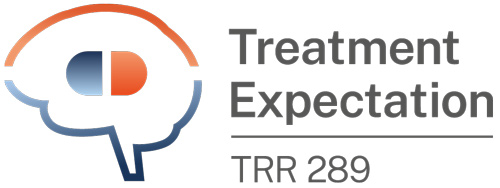Large quantities of imaging data enable us to generalise our findings and make predictions. © solvod/stock.adobe.com
Large quantities of imaging data enable us to generalise our findings and make predictions. © solvod/stock.adobe.com
Can imaging techniques help to predict the effect of treatment expectations on therapeutic outcome?
Imaging techniques such as functional magnetic resonance imaging (fMRI) or electroencephalography (EEG) enable us to visualise the anatomy, blood flow and function of the brain. This central research project analyses imaging data from ten collaborative research centre (CRC) projects, with the objective of pooling the findings and improving our understanding of the mechanisms underlying the effect of expectations on treatment outcome. Another objective is to identify characteristic biological features (predictive biomarkers), which in future will enable us to predict the effect of treatment expectations and optimise treatment for individual patients.
Central research project: neural imaging
This project is a pooled multicentre analysis of all neural imaging data generated by the CRC. The objective is to combine mechanistic data from individual projects with key general information in the form of biomarkers that are predictive of individual expectation effects on treatment outcome. The research strategy of this project focuses on a comprehensive data management plan, which includes the standardisation of data and metadata structure, imaging sequences and experimental protocols, automatic quality assessment and coordination of data transmission.
Recommended reading:
Büchel C, Peters J, Banaschewski T, Bokde ALW, Bromberg U, Conrod PJ, Flor H, Papadopoulos D, Garavan H, Gowland P, Heinz A, Walter H, Ittermann B, Mann K, Martinot J-L, Paillère-Martinot M-L, Nees F, Paus T, Pausova Z, Poustka L, Rietschel M, Robbins TW, Smolka MN, Gallinat J, Schumann G, Knutson B, IMAGEN consortium (2017) Blunted ventral striatal responses to anticipated rewards foreshadow problematic drug use in novelty-seeking adolescents. Nat Commun 8:14140. PubMed
Spisak T, Spisak Z, Zunhammer M, Bingel U, Smith S, Nichols T, Kincses T (2019) Probabilistic TFCE: A generalized combination of cluster size and voxel intensity to increase statistical power. NeuroImage 185:12-26. PubMed
Spisak T, Kincses B, Schlitt F, Zunhammer M, Schmidt-Wilcke T, Kincses ZT, Bingel U (2019) Pain-free resting-state functional brain connectivity predicts individual pain sensitivity. Nature Communications volume 11: 187 (2020) PubMed
Zunhammer M, Bingel U, Wager TD (2018) Placebo effects on the neurologic pain signature: a meta-analysis of individual participant functional magnetic resonance imaging data. JAMA neurology 75(11):1321-30. PubMed
In close cooperation with these projects
How we create our own expectations – and the role that attention plays in this
Prof. Dr. Christian Büchel
How expectations influence stomach ache – and how the experience of pain changes treatment expectations
Prof. Dr. Sigrid Elsenbruch
PD Dr. Julian Kleine-Borgmann
How do expectations control our emotions - and what does attention have to do with it?
Prof. Dr. Stefanie Brassen
How do positive expectations improve mood?
Prof. Dr. Erik M. Müller
Prof. Dr. Dominik M. Endres
This project has been completed.
Do positive expectations improve the effect of antidepressants?
Prof. Dr. Tilo Kircher
PD Dr. Irina Falkenberg
This project has been completed.
How do discussions with the doctor impact inflammatory symptoms and their treatment?
Prof. Dr. Sven Benson
Prof. Dr. Hana Rohn
How can expectation effects help to reduce pain after a hip operation?
PD Dr. Regine Klinger
Prof. Dr. Sigrid Elsenbruch
Project Lead

Prof. Dr. Ulrike Bingel
Neurologist and Neuroscientist

Prof. Dr. Christian Büchel
Neuroscientist

Prof. Dr. Tamas Spisak
Neuroscientist
Team
Dr. Raviteja Kotikalapudi
Postdoc, Neuroscientist
Dr. Balint Kincses
Postdoc, Neuroscientist
Giuseppe Gallitto
PhD Student, Neuroscientist
Robert Englert
PhD Student, Medical Technician






